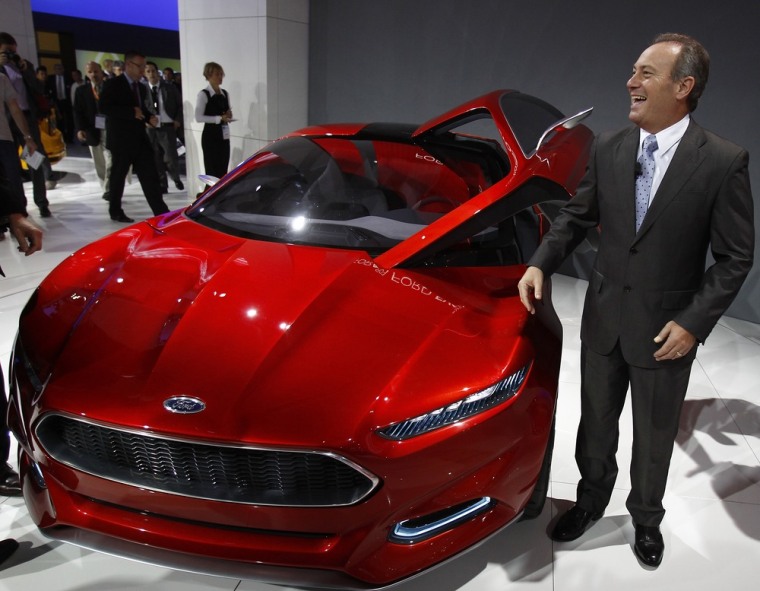Stock markets around the globe are plunging, consumers are retrenching and the threat of another recession seems to be on everyone’s mind these days.
Well, almost everyone. Optimism is the mood of the moment as the biennial Frankfurt Motor Show gets under way this week in Germany.
Never mind that Ford warned recently about sales missing estimates. No matter that automotive executives are watching the economic problems that are threatening to tear the European Union apart. Ford “comes to Europe with optimism,” insisted Stephen Odell, CEO of Ford of Europe, in a speech previewing the carmaker’s new line-up at the German car show.
In fact, Ford may have more reason for optimism than other automakers. The automaker has regained significant sales momentum this year after years of sales and market share declines that only complicated the problems it had in its home market. It has been sitting in the number two spot in Europe, this year, just behind Volkswagen AG — which is itself likely to be the second-largest automaker in the world when the numbers are added up for 2011, thanks to Toyota’s crushing production problems following the March earthquake and tsunami in Japan.
It’s not surprising, of course, to hear manufacturers speak of their hopes and aspirations — it’s what economists suggest consumers want to hear. And nothing spurs optimism more in the auto industry than new sheet metal. This year, there’s plenty of it on show in Frankfurt.
After delaying the introduction of many new models during the worst of the global economic downturn, manufacturers have opened the spigot on their product pipelines. Some 100 new vehicles were launched during the two media that came ahead of the show’s official opening to the public, according to estimates.
Perhaps the only ones visibly worried about the increase in car introductions were the 10,000-odd reporters gathered in the German financial capital to try to cover the event. Organizers have this year had to double up many of the news conference slots. Most of them were also cut short to just 15 minutes. That was complicated by the fact that it’s nearly a kilometer from one end of the sprawling Frankfurt Messe exhibition center to the other.
In hopes of standing out from the crowd, carmakers have been forced to stage advance “backgrounders,” hoping to get journalists to write more about their products than those of their competitors. The Internet is filled with more than a few “leaked” images that appeared to be stage-managed by the manufacturers themselves.
On the night before the first official media day, there were long lines of limousines and buses outside most of Frankfurt’s major hotels escorting reporters to parties where they could take a look at products they might not get to see during the frenzied media previews.
Volkswagen, for example, provided a look at all its dozen brands’ offerings, including the new production version of the VW Up! microcar, as well as a pair of battery-powered vehicles from its upscale Audi brand.
There are no formal plans to put the A2 show car and Audi Urban Concept vehicles into production — yet. But it’s clear that the various Volkswagen subsidiaries, from pedestrian Seat to luxurious Audi, are convinced that European buyers will continue to look for smaller and greener products that can help them navigate crowded urban roads and survive record fuel prices that, in some national markets, have topped $10 a gallon.
Small and fuel-efficient models are everywhere to be found at the various Frankfurt halls, and even luxury automakers are acknowledging the trend. Lexus has a new version of its GS450h hybrid. And Jaguar’s concept offering, the C-X16, would be, if it went into production, the smallest model the British marque has turned out in over half a century.
Mercedes-Benz, meanwhile, has a striking liquid silver-painted concept dubbed the F125! (exclamation points are in high demand this year). The F125! can run on clean, light hydrogen gas, while BMW stages the formal launch of its new “i” brand with the debut of the i8 and i3 battery-powered cars.
In typical form, the German marques dominate Frankfurt, much as the French brands show off every even year when the event moves to Paris. But with 50 different brands on display in Frankfurt, Teutonic carmakers are getting plenty of competition this year.
The Koreans are proving particularly aggressive, with Kia revealing a coupe-like sport sedan dubbed the GT and Hyundai revealing the i30, which will also be sold in the U.S. as a wagon version of the wildly popular Elantra.
The move by Hyundai underscores one of the significant changes that has reshaped both the auto show circuit and the industry as a whole in recent years: In decades past, a sizable majority of the products shown in Europe would never cross the Atlantic. But these days carmakers are pushing for ever-improved economies of scale, and that means more global products.
The smallest offerings, such as the Mercedes A- and B-Class models, still aren’t coming to the U.S., although that might change if fuel prices at home keep rising, company officials suggest.
Ford’s pre-show preview brought the unveiling of the Evos, a stunning coupe-like sedan with four gullwing-style doors.
“This is the new face of Ford,” said the carmaker’s global design chief J Mays. Although the car’s gullwing doors are “just showbiz,” according to Mays, Ford sources confirmed that many of the Evos’ design details will reappear on the stage at the Detroit Auto Show next January in the form of replacement versions of the U.S. Fusion sedan and European Mondeo.
Once completely separate vehicles, the two cars are now distinct only in their nameplates. By developing common vehicles that can be sold around the world Ford can afford to develop more niche vehicles to target selective groups of consumers.
That’s a strategy that most makers are now adopting, which is why there are 100 or more products all vying for attention in Frankfurt.
